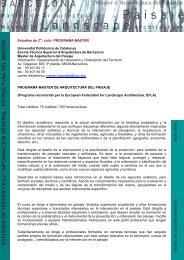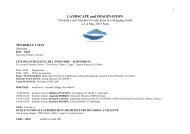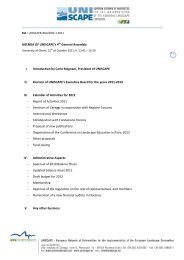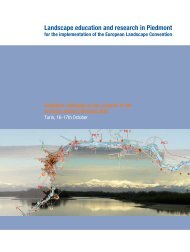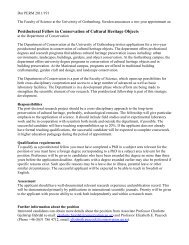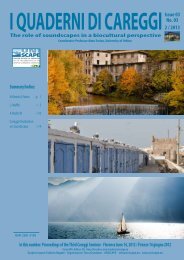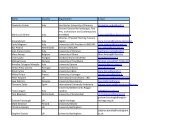Careggi Landscape Declaration on Soundscapes - Uniscape
Careggi Landscape Declaration on Soundscapes - Uniscape
Careggi Landscape Declaration on Soundscapes - Uniscape
You also want an ePaper? Increase the reach of your titles
YUMPU automatically turns print PDFs into web optimized ePapers that Google loves.
Florence, 14 th June 2012Ref: UNISCAPE CD2-14/06/12CAREGGI LANDSCAPE DECLARATION ON SOUNDSCAPES – JUNE 2012“<str<strong>on</strong>g>Landscape</str<strong>on</strong>g>” means an area, as perceived by people, whose character is the result ofthe acti<strong>on</strong> and interacti<strong>on</strong> of natural and/or human factors ….”European <str<strong>on</strong>g>Landscape</str<strong>on</strong>g> C<strong>on</strong>venti<strong>on</strong>, 2000Introducti<strong>on</strong>The soundscape can be defined as the acoustic property of every landscape according to aspecies' specific percepti<strong>on</strong> and is the result of physical (geoph<strong>on</strong>ies), biological (bioph<strong>on</strong>ies)and human (antroph<strong>on</strong>ies) features and dynamics.The soundscape is an important comp<strong>on</strong>ent of the terrestrial and aquatic envir<strong>on</strong>mentespecially from a human perspective, but it represents also an indispensable informative andcommunicative medium for every vocal animal. When lost or degraded it reduces the qualityof a landscape and impacts <strong>on</strong> the human well-being and more in general <strong>on</strong> the biologicalactivities of several organisms.Modern human societies have str<strong>on</strong>gly impacted <strong>on</strong> the soundscape, especially in urbanizedareas, reducing the acoustic quality and functi<strong>on</strong>s of the surroundings. Noise polluti<strong>on</strong> inurban areas is a problem for the health of billi<strong>on</strong> of people at every latitude.The quality of the soundscape is an important aspect not <strong>on</strong>ly in natural areas but also incultural landscapes and in historical sites and m<strong>on</strong>uments because it c<strong>on</strong>tributes to makeresidents and visitors fully benefit of such valuable heritage.To preserve a soundscape and to mitigate the anthropogenic noises it is important to reduceunnecessary acoustic sources associated to mitigati<strong>on</strong> planning strategies.The protecti<strong>on</strong> and management of a native soundscape represents a qualified goal tomaintain in situ the biodiversity and to guarantee the ecosystem's functi<strong>on</strong>ality as well.Educating to listen is the obligate step to recognize the strategic value of the soundscapes andto support a protecti<strong>on</strong> and management policy. The creati<strong>on</strong> of data banks of threatenedsoundscapes is <strong>on</strong>e important acti<strong>on</strong> to preserve the memory of the past complexity that canbe used in the future to establish more favorable acoustic c<strong>on</strong>diti<strong>on</strong>s especially in urban areas.To face the soundscape matter a multi-disciplinary and integrated approach is requiredbecause the soundscape is a focal point for many scholars (e.g. acousticians, bio-acousticians,engineers, planners, artists, psychologists etc.), therefore a world permanent forum must beencouraged to disseminate ideas, research projects, management.
1- <str<strong>on</strong>g>Landscape</str<strong>on</strong>g> strategy for your regi<strong>on</strong>. Characterizing soundscapes (but not <strong>on</strong>ly these…)1.1- Policy makers should c<strong>on</strong>sider soundscapes as an important comp<strong>on</strong>ent of landscapeplanning and management since the s<strong>on</strong>ic envir<strong>on</strong>ment reflects human culture and naturalheritage and effects our quality of life and health.1.2- Main point of reference for valuating soundscapes is the well-being of the people, thelocal community.1.3- <str<strong>on</strong>g>Landscape</str<strong>on</strong>g> should be lived and valued in a multisensorial way. Surveys <strong>on</strong>multidisciplinary basis am<strong>on</strong>g inhabitants and visitors are crucial to define the perceivedvalues of the landscape, and the measure to which these characterize specific landscapes.1.4-“Sound-marks” (including local dialects) may be defined just as well as landmarks.<strong>Soundscapes</strong> are by definiti<strong>on</strong> dynamic, and more characterized by rhythm (day-night,seas<strong>on</strong>) than by c<strong>on</strong>tinuity.1.5- Narratives describing typical landscapes and associated soundscapes are more powerfulthan maps.1.6- It should be promoted that landscape and urban planning be based <strong>on</strong> multisensorialpercepti<strong>on</strong> of the living envir<strong>on</strong>ment.1.7- Indicators for characterizing soundscapes are rather to be found in localized qualitativestatements, to be related to more general quantified parameters <strong>on</strong> a regi<strong>on</strong>al level.1.8- The disturbing effects of human activities in underwater and underground are to bec<strong>on</strong>sidered.2- Educati<strong>on</strong> and raising awareness2.1- The first step in raising soundscape awareness is to improve listening skills. This can beachieved by a series of activities (for ex., soundwalks, sound recogniti<strong>on</strong> exercises etc.) to beproposed to the general public including educati<strong>on</strong>al Instituti<strong>on</strong>s.2.2- Sounds are perceived not <strong>on</strong>ly <strong>on</strong> a perceptive level but also <strong>on</strong> an emoti<strong>on</strong>al level thusinformed sound making and sound-art is relevant to enhancing awareness.2.3- Raising awareness and at the same time preserve and manage soundscapes can bereached though specifically designed facilities such as sound libraries and s<strong>on</strong>ic museums.2.4- Educati<strong>on</strong> should ultimately aim at integrating soundscape awareness into a holisticpercepti<strong>on</strong> of landscapes.3-Scientific aspects for landscape c<strong>on</strong>servati<strong>on</strong> and management3.1 Integrati<strong>on</strong> am<strong>on</strong>g the different approaches made by different field of expertize andmultidisciplinary approach.3.2 It is urgent to develop a research policy in soundscape ecology (SE) 1 because the acousticaspect of landscape is underestimated3.3 The SE must be positi<strong>on</strong>ed under the umbrella of the landscape epistemology.3.4 It is important to define the ecology of the Soundscape: limits and tools3.5 It is recommended a standardizati<strong>on</strong> of sampling and processing methodologies.3.6 The Soundscape of historical urban sites and its character should be c<strong>on</strong>sidered a value(tourism, cultural heritage and quality of life).1The Soundscape Ecology is the study of the relati<strong>on</strong>ships between the envir<strong>on</strong>mental sounds and theinteracting organisms. These include the characterizati<strong>on</strong> of the soundscape of a geographical c<strong>on</strong>text, howorganisms perceive the acoustic c<strong>on</strong>figurati<strong>on</strong> of the landscapes and the effects of anthropogenic acousticdisturbance across scales.2
Annex 1Background:The statement is based <strong>on</strong> the outcome of the Third <str<strong>on</strong>g>Careggi</str<strong>on</strong>g> Seminar The role ofsoundscapes in a biocultural perspective that took place in Florence the 14 th of June 2012in the Presidency of the Tuscany Regi<strong>on</strong> (Sala Pegaso) Piazza Duomo 10.Taking into c<strong>on</strong>siderati<strong>on</strong>the introducti<strong>on</strong> and welcome addresses of the morning by:Anna Mars<strong>on</strong> Minister for Spatial Planning and Territory,Tuscany Regi<strong>on</strong>;Bas Pedroli, University of Wageningen, Director UNISCAPE;and the presentati<strong>on</strong>s by:the coordinator of the seminar Almo Farina (Urbino University),Nadia Pieretti (Urbino University), Henrik Brumm (Max Planck Institute for Ornithology,Seewiesen), David M<strong>on</strong>acchi (Pesaro Music C<strong>on</strong>servatory), Luigi Maffei (Sec<strong>on</strong>daUniversità di Napoli), Ant<strong>on</strong>ella Radicchi (Tempo Reale, Firenze).The participants of the seminar agreed to focus <strong>on</strong> three aspects:1. <str<strong>on</strong>g>Landscape</str<strong>on</strong>g> strategy for your regi<strong>on</strong>. Characterizing soundscapes (but not <strong>on</strong>ly these…)Luigi Maffei, Ant<strong>on</strong>ella Radicchi, Bas Pedroli2. Educati<strong>on</strong> and raising awarenessDavid M<strong>on</strong>acchi, Henrik Brumm, Emiliano Battistini, David M<strong>on</strong>acchi, Franca Battigelli3. Scientific aspects for landscape c<strong>on</strong>servati<strong>on</strong> and managementAlmo Farina, Nadia Pierettidecided to divide themselves in 3 groups in order to develop statements.After about an hour each group shared its statements with the rest of the participants and allthe participants added comments and suggesti<strong>on</strong>s to each statement.3



